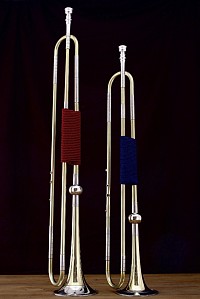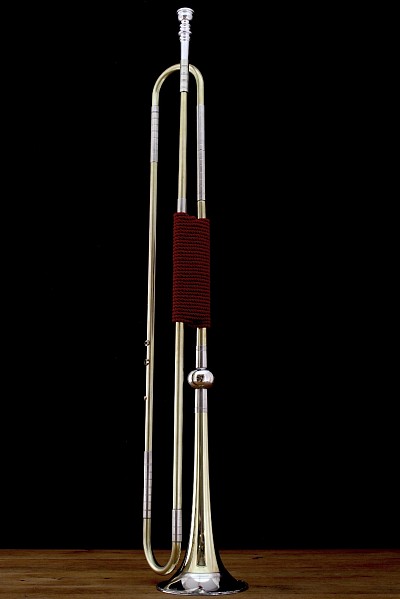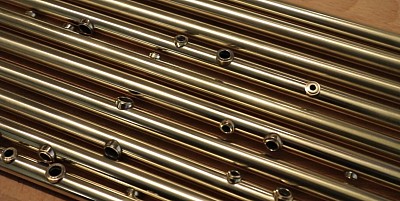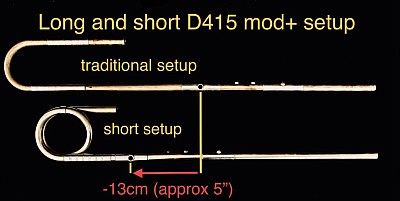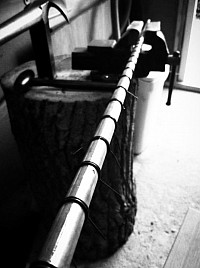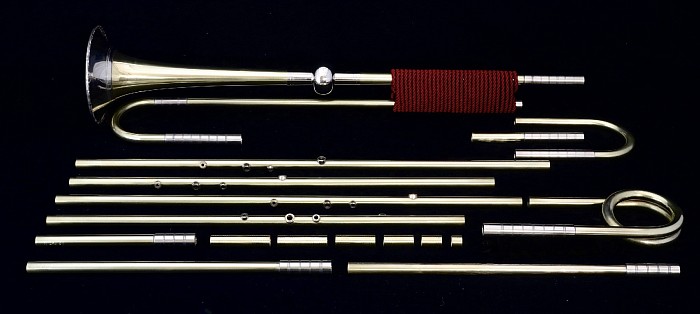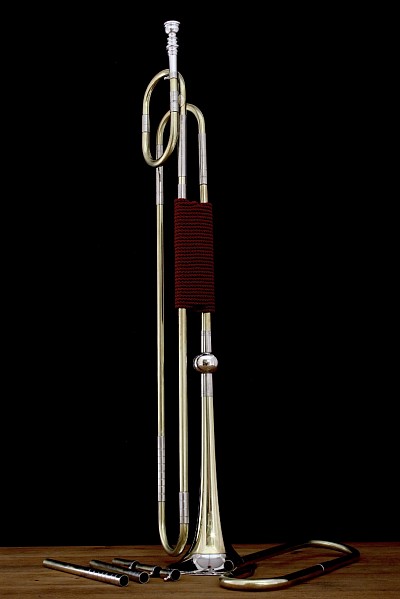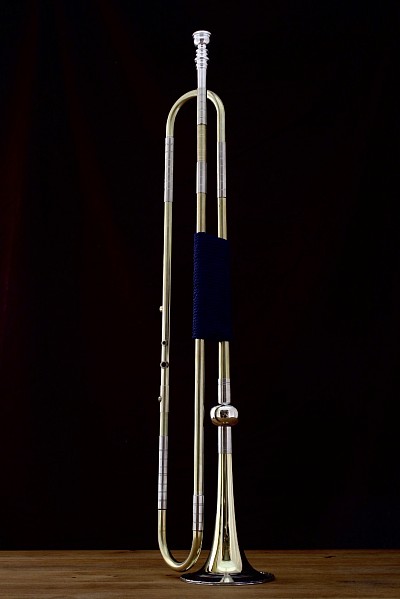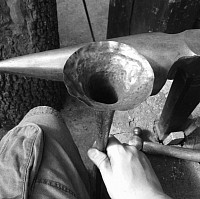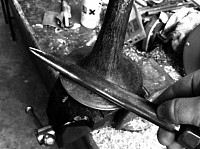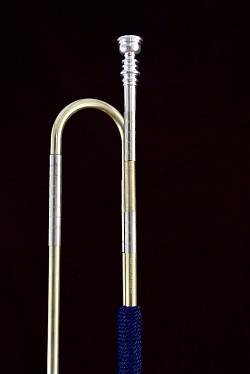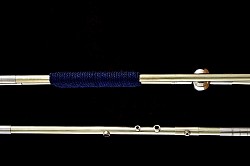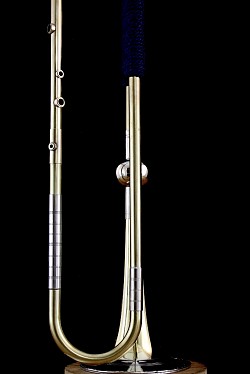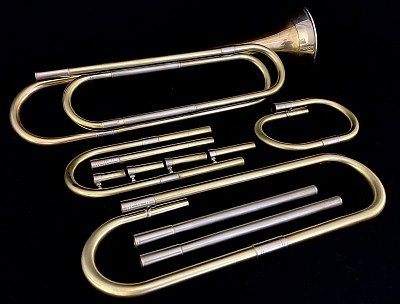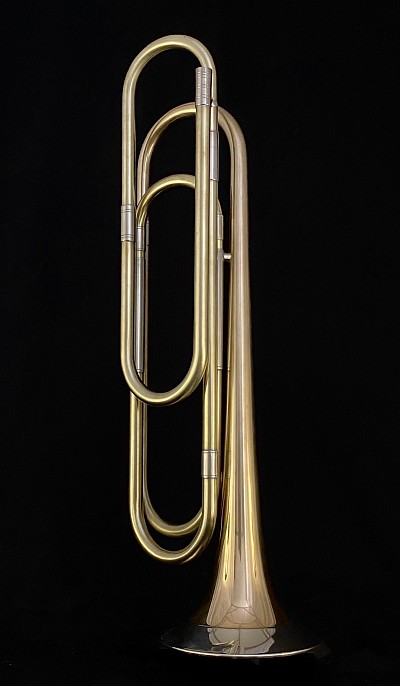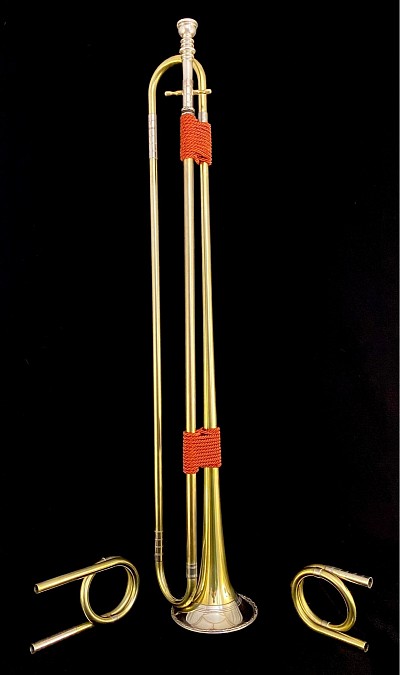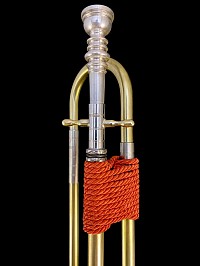Historic Trumpets
Natural Trumpets
The historic, valveless instruments we make are usually called “baroque trumpets” or “natural trumpets”. This is because these instruments notes are the natural overtone series. Compared to valved instruments these historic instruments are quite limited in which notes can be played on them. Bach, Handel, Purcell and other great composers from this time (and before and after) wrote for these instruments. Characteristic for the music written for the natural trumpets is that most of the time this instrument is played in the upper register to be able to play diatonic phrases.
Our historic trumpet programme is a result of more than 15 years of constant development. Because another part of Mark’s professional life is playing on (modified) copies of historic instruments we have the opportunity to test all these products through and through. Colleagues from all over the world test and give us their honest feedback as well. It’s an ideal situation to be in as instrument builders. As result of this every year more professional colleagues play on instruments made by us
The video below shows some of the workshop and Mark’s view on natural trumpet building. It was made for the Nederlandse Bachvereniging since Mark has been playing with that (wonderful) group of people since 2005.
About the MOD+ model
As you might have heard in the above video most of the performing artists in the historic field play on modified historical copies. This usually means that an instrument out of a museum is measured and copied. Then as last step in the process the modern ventholes are added. We don’t find this a logical approach.
It is quite certain that ventholes are a modern invention. As we are aware of the dramatic effect of adding them our design process is a little different. We have designed the natural trumpets completely around the ability to play with or without ventholes whilst keeping a sound that is as close to “historic” as possible. Curious? Look here.
This does not happen when a museum instrument is copied and simply has ventholes added. Mark thinks more like a performer than a historian and he is of the opinion that if performance is already “compromised” by the choice to use ventholes it is important that these ventholes really work without compromising the sound and ease of play.
Leadpipes
The natural trumpets we make can be used with three different leadpipe systems, making the system even more versatile.
1) Historic: A historic taperless leadpipe system that can be used with historic tuning bits. Good for no hole playing.
2) Flextune (GR): The Mod+ standard insert type system (with or without desired GR tapers) that slides into the first yard of the trumpet, thus creating a natural “smaller’ start of the instrument. Especially nice for lower pitches and finetuning classical venthole playing.
3) Fixtune GR: A traditional venthole trumpet leadpipe system that requires different length leadpipes to cover all the keys / pitches. Mostly used for baroque playing in C and D.
Venthole Yards
The venthole yards for all the keys and pitches are dedicated to them, with a few exceptions. This means that every key and pitch has it’s own venthole yard for perfect allignment. These yards can even be produced with sliding F and C holes if desired. If you’d like to see how accurate the ventholes are you can take a look here. In this video you see that the low G and C can also be played with the “octave” venthole. This is very unusual and is only really possible if this hole is in the perfect spot giving exactly the right amount of resistance.
The venthole yards can have custom aligned venthole covers to suit your hands and ergonomics. This is a service that is FREE of charge and can also be done without a physical visit to the workshop.
Short mod+ D415 crook and yard
To some people the four hole trumpet is difficult to hold comfortably in D415 because the ventholes are positioned too far away. This can result in a tensed or compromised posture. This is not beneficial to a relaxed playing experience. And for some players even a reason to play a three hole trumpet instead.
This is why we offer a special D415 crook and yard for people with smaller hands / uncooperative joints / shorter arms or people that just want to have their instrument set up in the most comfortable way without having to compromise.
As you can see the holes have moved around 13cm (5”) closer to the player compared to the traditional setup. But that is not all because the leadpipe is also shorter in this setup. This makes the total “increase of comfort” around 20cm (8”) which makes it very easy and comfortable to hold and play.
Using an extra loop to help with moving the holes closer is not something we have invented. But doing so without compromising the sound and ease of play/intonation is something new on the market. This has to do with the way the crook is produced and constructed.
The set is around €425 (depending on the fluctuating material prices) and compatible with the MG mod+ trumpets and is available for (near) immediate production. If you have questions then please contact us directly.
More Options
Since everything is made in house we can make nearly everything you wish for your natural trumpet but we am not listing it all here to keep the website “to the point”
For more info about anything regarding the trumpets please contact us.
Below you can listen to Danny Teong playing G. Reiche’s “abblasen” on his Mod+ trumpet with Fixtune D leadpipe. Note how the colour of the notes stays very even with the use of ventholes. Besides a good playing technique the trumpet helps Danny a lot.
Basic Mod+ set in 440-415
Historic Playing
The bell on the MOD+ model is very much like an EHE bell but still slightly different because we have implemented the Golden Ratio (Fibonacci) sequence. Not only in the shape of the bell but in many other ways. Whenever there is a taper, and whenever balance and proportion is important.
Besides that we make sure to make a (one piece!) bell that is light enough with a standard 0.35mm wall thickness. This gives a nice direct response without the sound wavering away. And it still has enough “mass” to carry and blend nicely. Just like most original historic natural trumpets.
One of the strong points of my MOD+ instrument is that it can also be used without the use of these ventholes and function as a “historically correct” holeless trumpet. A few important bits can be swapped (by the player) to activate the historic characteristics of the holeless trumpet. The (usually problematic) F and A are much easier to play on this instrument.
The historic crook setup is a complete solution that can be used for both baroque and classsical repertoire. This set of crooks works beautifully on both the dedicated classical corpus (please scroll down) but also on the Mod+ natural trumpet. Martinus uses this crook set when he plays with the Orchestra of the 18th century and it works like it should.
High Pitch Trumpet ~ Aether ~
This trumpet is designed to cover the high pitch demand of specialist natural trumpet players. It is a slimmed version of the Mod+ trumpet and works great in the tunings Eb430 all the way up to F440. It overlaps seamlessly with the Mod+ trumpet that goes from A430-Eb440.
Important is obviously that the instruments helps the player that wants to perform the brandenburg concerto. The smaller bell and smart leadpipe system really help to keep the sound compact, slim and pretty and the resistance even enough to be able to stay in the upper register without stretching stamina to the max.
Different (custom) leadpipes can be made to make the instrument work perfectly for you. And because every player is different the venthole yards can be made with moveable F and C holes. A recording of the brandenburg concerto played on the ~ Aether ~ trumpet will follow soon!
4hole trumpets vs 3hole trumpets
If you are considering to buy a natural trumpet with vent-holes, one of the first decisions you need to make is what kind of trumpet to go for. A short bendy 3hole instrument or a long historic looking 4hole model. Both models are compromises that are widely used in Europe and the rest of the world.
Besides an instrument builder our historic expert Mark is active as a professional natural trumpet player. He has played many different instruments over the last twenty years. The first 6 years on short 3hole instruments only. Later almost exclusively on 4hole instruments. As a player he developed a strong preference for 4hole trumpets, especially for baroque repertoire. The 3hole instruments also have their qualities, but he feels that the 4hole trumpets are a more logic choice.
This preference is for pure practical reasons. These reasons are in the first place “sound” and in second place “playability”. A long model trumpet sounds dark and rich at the same time. Another way to describe the sound is “pure”. Short trumpets tend to sound more nasal and they tend to feel stiff, especially in the lower register. Played with the use of vent-holes the long model is very flexible and stable (resistance-wise) over the whole trumpet register without compromising sound too much. Played with and without the vent-holes the four-hole trumpet sounds very close to a historic trumpet. This is mainly because of the correct proportions and even more so the shape and length of the bell.
Technical differences
The big compromise on the short three hole trumpets is the shorter bell. The start of the bell has been cut off, interrupting the most important (and only!) long taper that it is also present on a fully historic trumpet. The bell on the short trumpets is made shorter to make the trumpet easier to hold and to make the ventholes more accessible. That seems practical, but this makes it nearly impossible to play “no holes” on a short instrument. This is because the proportions are lost. Not to mention the fact that on the three-hole trumpet there are some notes (like the written D2) that don't seem to be happy to be played at all. On the four-hole trumpet this problem is non existing. Although the short and long trumpets are different, in practice they can be used in the same trumpet section without problems.
We feel that the three hole instrument has reached it’s peak, and has nearly finished developing thanks to instrument builders like (f.e. Egger Instruments in Switzerland) that have invested a lot of time and effort in the development of the three-hole trumpet.
The four-hole trumpet has not finished developing to modern requirements yet. Even our very first building attempts following simple logic worked out surprisingly well. The four-hole trumpet is a great starting point because of it’s basic shape (and history..) but it can be made much better. There is great potential, and that is the reason why we keep developing long baroque trumpets only. More comfortable options to bring the ventholes closer in the key of D415 on our four-hole are available now so the ergonomic advantage the three-hole trumpet used to have is no longer a reason to not play a more up to date four-hole trumpet!
Classical “Eroica” Trumpet corpus and Crooks
The “Eroica” classical trumpet corpus is designed for playing classical repertoire and allows hand stopping. The wall thickness over the whole length of the instrument is 0.4mm, including the bell.
The key changes for F-E and Eb are done by changing the tuning slide. From Eb down the instrument is crooked down with the classical crook set and bits at the moutpiece receiver side. We made this choice for geometrical reasons. The complete set shown in the photo above makes it possible to properly play from high F to low A in 440 and 430.
The crooks and tuning bits that come with this instrument (also sold seperately as “classical crook set” will also fit the regular MOD+ natural trumpet in Eb. So if you already own that you can dip your toes in first using the classical crooks on your mod+ trumpet and then upgrade to the “Eroica” corpus over time for the full classical experience.
The bell shape used for the classical corpus has a slightly bigger throat than a late baroque style bell, sounds darker and has a touch of horn timbre in it. It blends beautifully with natural horns and classical wind instruments. The garland gives stability to the bell and looks pretty, just as all the other nickel silver trims and ferrules. You might wonder why there are no vertical braces (often seen on original instruments) present on this instrument. This is because the instrument simply plays and sounds so much better without them. In exchange for these braces we have made the instrument more rigid by adding some soldering points in the horizontal direction. Besides that we offer handy transport tools for the three tuning slides that come with the instrument.
Single Slide Trumpet for Baroque Repertoire
This slide trumpet developed in collaboration with slide specialist Alexandra Mikheeva is a practical solution for playing a single slide trumpet comfortably in D415, C440 and C415. At first I thought this was going to be a one off build but it is such a nice playing and sounding instrument that it sparked interest quickly. So I decided to make it available for orders. Although the design looks a little quirky it is comfortable and practical, and still a “die hard” single slide!
The trumpet has the same bell shape as the Mod+ four hole trumpet. The overal bore is 11.0mm and the wall thickness is 0.4 for the tubing and 0.35 for the bell. Playing in different pitches is done just by changing the back bow / crook. For more info or questions please contact me.
